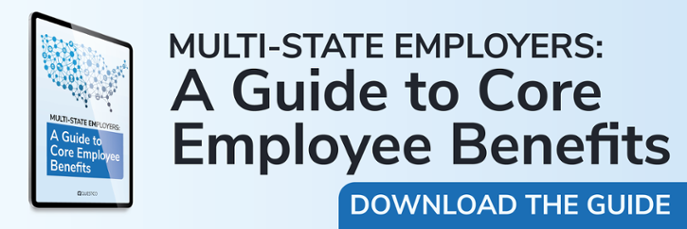Topic Outsourcing HR / PEO,
Multi-State Employers: Do You Know Where to Remit State Unemployment Taxes?

January 12, 2023 | By Questco

In the U.S., the federal unemployment tax rules and various state unemployment laws create a hassle for multi-state employers. Whether you have remote workers or workers who live in one state but work in another, questions arise as to which state you must pay unemployment taxes.
Your answer to that question impacts both your state and federal unemployment taxes.
What happens if you remit payments to the wrong entity? And if you’ve paid the wrong state, what can you do to get a refund?
FUTA vs. SUTA Considerations
Employers face unemployment payments under both federal and state laws. State unemployment insurance (SUI) taxes are codified in the state unemployment tax act (SUTA).
SUTA refers to the state laws that require employers to remit payroll taxes to fund state unemployment payments to unemployed workers.
The term used for the payroll tax varies by state jurisdiction, but for purposes of this discussion, the SUTA tax and the state unemployment insurance tax are synonymous.
Local SUI tax rates vary from state to state, as does the taxable wage base subject to those taxes.
Federal unemployment taxes are under the oversight of the Federal Unemployment Tax Act, or FUTA. Employers make FUTA tax payments into a federal fund that monitors each state’s unemployment insurance programs.
FUTA requires a federal tax on employers covered by state unemployment insurance laws. The funds collected under the federal tax law create the Federal Unemployment Trust Fund, which the U.S. Department of Labor (DOL) administers.
What Happens If I Send Unemployment Insurance Taxes to the Wrong State?
When it comes to multi-state employees, there may come a time when you remit unemployment taxes to the wrong taxing entity. If you pay SUTA taxes to the wrong state, you may file for a refund from the incorrect state.
In some cases, your FUTA tax may include a tax credit reduction. The federal government must approve any state law that provides a credit for SUTA taxes paid to the state, up to a credit of 5.4% against the tax imposed under FUTA.
Where Do I Remit SUTA Taxes if an Employee Works and Lives in Different States?
Luckily for multi-state employers, compliance is easy when determining where to pay state unemployment insurance taxes.
The state determined as the “worked-in” state bears the responsibility for unemployment compensation insurance as opposed to the “home” state. The multi-state employer submits quarterly wage reports and contributions to the “worked-in” state.
What if the Remote Employee’s Work Transfers to a Different State?
All states (except Louisiana and Missouri) allow employers to carry forward the wages previously paid to the employee during the same calendar year and apply them against their taxable wage base. This often lowers the taxable salary that applies to one of the states.
When an employee’s work is temporarily transferred to another state, the multi-state employer should continue to pay SUTA taxes to the state where the employee typically works and has unemployment coverage.

What if the Remote Employee Works in Two Different States?
All states have agreed to DOL’s five-step analysis to determine where unemployment insurance taxes should be paid. The below questions are asked in the order shown. If you answer any question with “yes,” that state is your coverage state.
Step #1: Service Localization
The first step is determining whether the employee performed all the services within one state. If the answer is yes, then the service is localized to that state jurisdiction.
Suppose the employee performs work inside and outside a state. However, the outside services were incidental to the services performed within the state. In that case, the work is considered localized to the state where the non-incidental work was performed.
If the work is not localized within the state, then the next step in the analysis takes place.
Step #2: Base of Operations
A base of operations refers to the place where the employee has an office, acquires work instructions, gets mail, or where the employee keeps their business records.
Suppose the base of operations is located within a state where the employee performs some work. In that case, the employer should report all the employee’s wages to the base of operations state.
Step #3: Direction and Control
If the employee’s work does not satisfy the localization rule and the employee has no base of operations, where do directions and immediate control over the employee’s service emanate?
If there is a state where the employee receives direction or control, then the employer should report all the employee’s unemployment taxes to that state.
Step #4: Employee’s Resident
If an employee’s services do not satisfy the previous three prongs of the analysis, then the employee’s state of residence will have jurisdiction over the unemployment tax issues.
Step #5: Determination through State Law
Employers want to avoid making excess payments for employees who work in more than one jurisdiction. Toward that end, many states permit employers to pay unemployment taxes to a state that satisfies one of the above tests.
This scenario tends to be within the context of construction workers who may work six months in two different jurisdictions, satisfying the localization test for each state.
To prevent overpayment, the employer would pay unemployment insurance taxes for all the performed services to one of the states.
What if States Enter into a Reciprocity Arrangement?
All jurisdictions (except Alaska, Kentucky, Mississippi, New Jersey, New York, and Puerto Rico) follow the Interstate Reciprocal Coverage Agreement.
The purpose of the reciprocity arrangement is to provide unemployment compensation coverage under the laws of one state for services performed in more than one jurisdiction.
The reciprocity arrangement avoids duplication of unemployment compensation contributions and assures continuity of coverage for employees who perform in more than one state jurisdiction.
Simplify Multi-State Unemployment Taxation with a PEO
A professional employer organization (PEO) is your human resource outsourcing partner. The PEO becomes your co-employer to remit payroll taxes and give you access to Fortune 500-level employee benefits at a better price than you could afford on your own.
PEOs cut through administrative burdens and will help determine the state where you should withhold payroll taxes. The PEO can also help you take advantage of potential refunds for past errors in payment.
For example, an employer may pay SUI taxes in every jurisdiction where the employee worked. This may cause the employer to overpay SUTA. A PEO can help you apply for refunds of the overpaid expense.
Example of unemployment tax refund scenario:
Employer A has 1,000 employees who perform work in Illinois. The Illinois unemployment tax rate is 3.1%, and the wage base for SUTA is $9,000.
On July 1, the employer transfers all 1,000 employees to Minnesota. Minnesota’s unemployment tax is 5.4%, and the wage base is $22,000. The employer pays SUTA tax on all employees at the Minnesota rate. The amount due is 1,000 x $22,000 x 5.4%, or $1,188,000.
Applying the SUTA paid to Illinois as a credit, the Minnesota tax for half the year is only $702,000, leaving a refund owed of $486,000.
For this reason, it’s essential to review SUTA and FUTA rates annually. Employers can see tax savings resulting from the relocation and hiring of multi-state workers.
Please note that the information presented above is not intended to be specific, technical, or professional advice. Our aim is to educate and provide insight into relevant topics.



